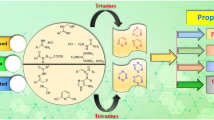Abstract
The reaction of 1-methylthio-3,3-dimethyl-6,7-di-R-dihydroisoquinolines with carboxylic acid hydrazides gives the corresponding hydrazides converted into derivatives of 1,2,4-triazolo[3,4-alisoquinoline. Reaction of these dihydroisoquinolines with hydrazine hydrate gives the corresponding 1-hydrazinoderivatives which with NaNO2 give tetrazolo[5,1-aisoquinolines, and with oxalyl chloride (where R = H), 1,2,4-triazino[5,1-aJisoquinoline.
Similar content being viewed by others
References
M. D. Mashkovskii, Drugs [in Russian], Meditsina, Moscow (1988).
H. Bartsch, T. Erker, and G. Neubauer, Heterocycles,26, No. 1, 205 (1989).
W. J. Gensler, Isoquinolines, in: Heterocycles, R. C. Elderfield (ed.), Wiley, New York (1952), p. 381.
B. B. Aleksandrov, M. Yu. Dormidontov, V. S. Shkiyaev, and Yu. V. Shklyaev, Khim. Geterotsikl. Soedin., No. 7, 995(1990).
Additional information
Institute of Industrial Chemistry, Urals Branch, Russian Academy of Sciences, Perm 614000. Translated from Khimiya Geterotsiklicheskikh Soedinenii, No. 4, pp. 511–514, April, 1994. Original article submitted November 17, 1993.
Rights and permissions
About this article
Cite this article
Aleksandrov, B.B., Glushkov, B.A., Glushkova, E.N. et al. Polyazole systems based on 3,4-dihydroisoquinoline. Chem Heterocycl Compd 30, 449–452 (1994). https://doi.org/10.1007/BF01169940
Issue Date:
DOI: https://doi.org/10.1007/BF01169940




